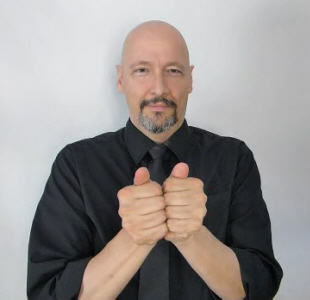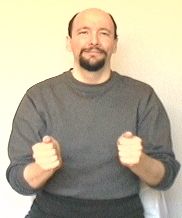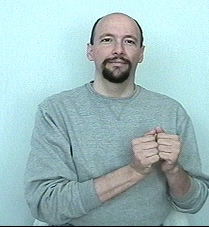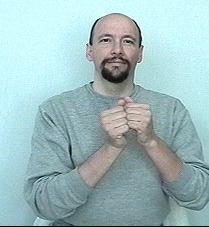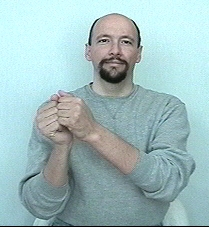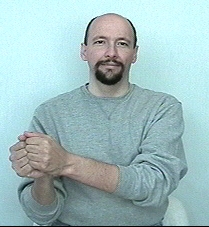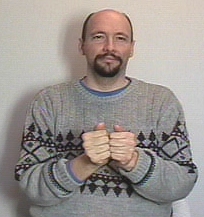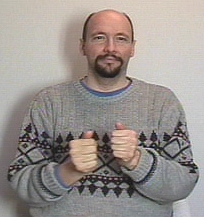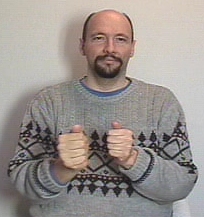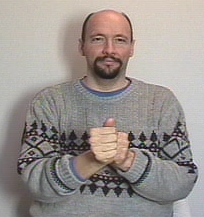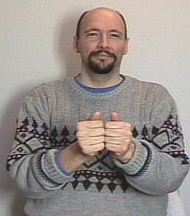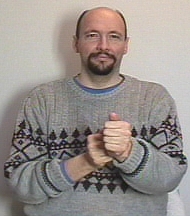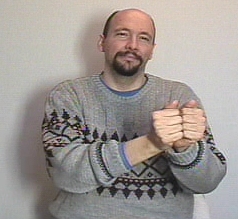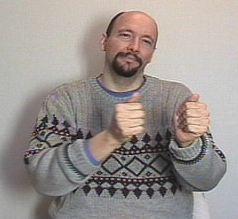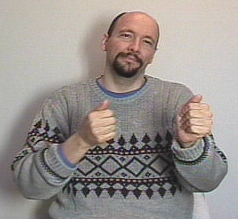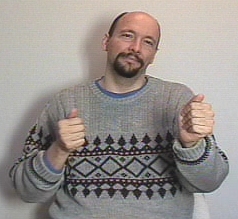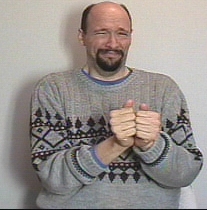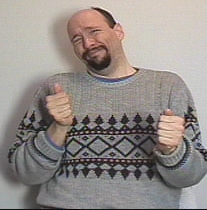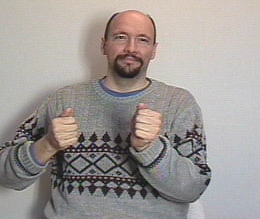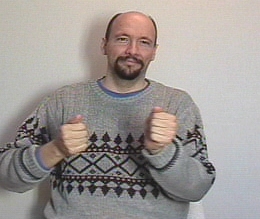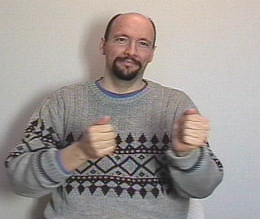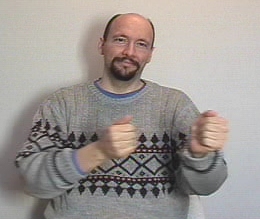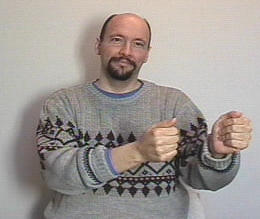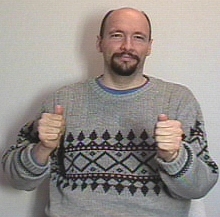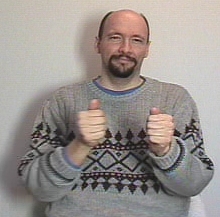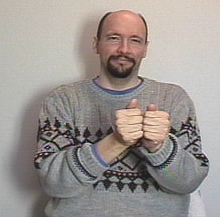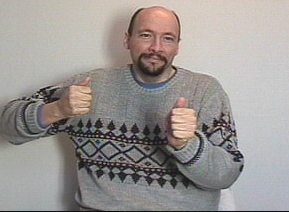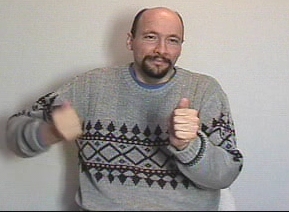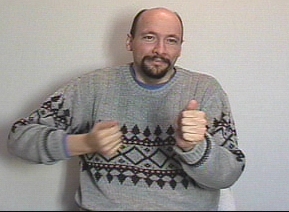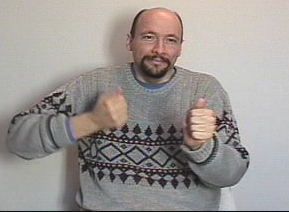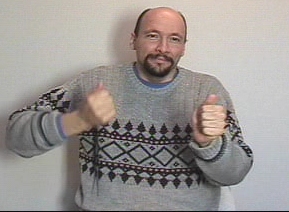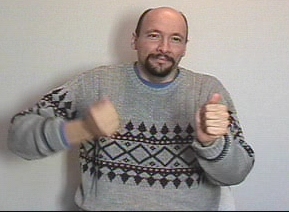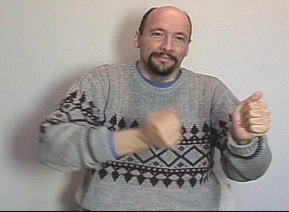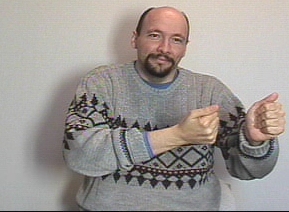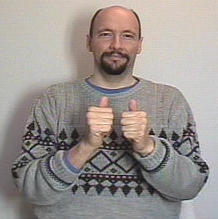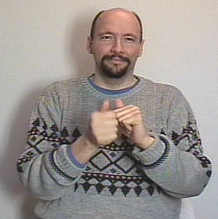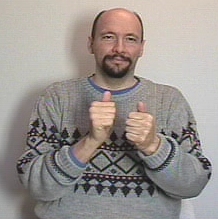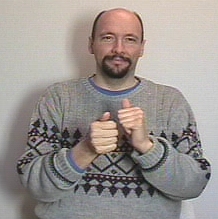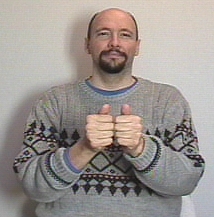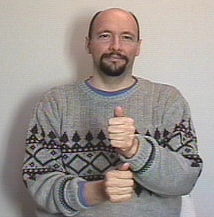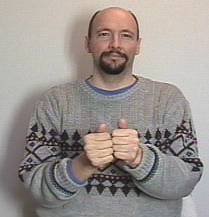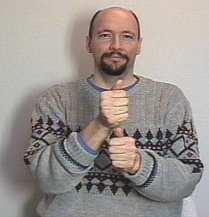American Sign Language: "with" (advanced
discussion)
WITH:
The sign for "with" is the basis for many other signs including:
WITH
ACCOMPANY
AHEAD
BEHINDFALL-BEHIND
FOLLOW
CATCH-UP
CHASE
RACE-COMPETE
SUBORDINATE
SUPERIOR
TOGETHER-with-someone-long-term-["go steady"]
See below for more info.
ACCOMPANY
AHEAD
BEHIND
FALL-BEHIND
FOLLOW
CATCH-UP
CHASE
RACE-COMPETE
SUBORDINATE
SUPERIOR
TOGETHER-with-someone-long-term-["go steady"]
Notes:
Dear Dr. Bill,
If I'm letting someone know that I am learning sign using the internet...would I sign: "I LEARN SIGN WITH INTERNET"? Or does WITH convey more of a 'together' concept? Should I instead sign: I LEARN SIGN, USE INTERNET?
- Alex
------
Hello Alex,
No. The sign WITH is not used to mean "via" as in, "I'm learning sign via the internet."
Actually you do not need the concept of "with" or "via" in this sentence. The sign "INTERNET" also means "online."
Thus you could sign:
"I LEARN SIGN INTERNET I" Which is a way of saying, "I am learning sign language online."
In English you wouldn't dream of saying, "I am learning sign language with online" would you?
Or if it is a dialog it might go like this:
Signer A: "YOU LEARN SIGN HOW?"
Signer B: "INTERNET"
- Dr. Bill
The sign for "WITH" is made by forming the letter "a" with both hands. Place both your hands together, palms facing.
WITH:
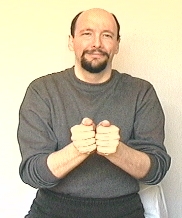
If you hold the "A" hands together and then make a sweeping horizontal circle (while keeping them together--looks like you are stirring a witch's brew on Halloween) it means "all together" or can be just labeled as "TOGETHER."
TOGETHER-[collectively] / all together / solidarity-[version]
See: https://youtu.be/H8frIh9Lb_A
Suppose you want to sign "Go with?" Use this sign for "accompany." It can mean, "Come along." If you sign "WANT ACCOMPANY?" after indicating that you are going to the store, that would mean that you are asking the person if he or she wants to go with you to the store. You don't need a separate sign for "GO."
ACCOMPANY:
If you start with them together then move the dominant hand in front of the non-dominant hand, it means "ahead" or "ahead of."
AHEAD:
BEHIND ("in back of")
If you start with them together then move the dominant hand behind the non-dominant hand, it means "BEHIND."
FALL-BEHIND:
Hold your "A" hands together, out away from your body, a bit off to your non-dominant side. Then pull your dominant hand backward (away from the non-dominant hand). If you do a quick simple movement it means "behind schedule" or "not up with the others." If you do a slower movement and "waggle" it a bit you can change the meaning into "falling behind." You might even see the mouth opened a bit and the tongue over the lower teeth (which is what a person who is tired and panting looks like) used to emphasize "not being able to keep up."
AVOID:
If you start with both the non-dominant hand and the dominant hand out from your body (slightly off to your non-dominant side) and then pull the dominant hand back toward the dominant side of your body it means "FALL-BEHIND" (Or it can also mean AVOID.)
FOLLOW:
If you start with the non-dominant hand a little bit ahead and then move them both forward and to your non-dominant side in a smooth steady motion it means "FOLLOW." The dominant hand doesn't "catch up" to the non-dominant hand. It just follows it.
CATCH-UP:
If you start with the non-dominant hand farther ahead and the dominant hand back near your body then move the dominant hand up to the non-dominant hand it means "CATCH-UP."
If you start with the non-dominant hand a little bit ahead and then move the non-dominant hand forward and to your non-dominant side in a smooth steady motion while moving the dominant hand forward and toward the non-dominant side of your body in a spiraling motion it means "chase."
CHASE:
If you alternate moving your hands forward and back (so that one is farther out than the other) it can mean race or competition. (This is not used for things like a person's heritage. For that kind of race, just spell R-A-C-E.)
COMPETE:
Animation: RACE / compete
If you start with them together then move the dominant hand under the non-dominant hand, it means "subordinate" as in: lower in rank / an object stacked under another object, underling.
SUBORDINATE:
SUPERIOR: (above in rank, on top of, placed over)
If you hold the "A" hands together and then move them forward and back about three inches using a double motion it means "GO-STEADY" (as in dating someone for a long time).
TOGETHER-long-term / be with someone exclusively / "go steady"
YOU TOGETHER-with-someone-long-term?
More thinking on the sign FOLLOW.
1. The "uninflected" sign FOLLOW is not directional in the same sense that the uninflected sign GIVE is not directional (at the moment it is signed in a non-directional way). However both signs "can be" used in a directional manner. This is common for most "so called" directional signs. Most have uninflected non-directional base signs. For example MEET (the version that uses index fingers). You can inflect that sign to mean "I met [he / she / that person / them]
2. The sign FOLLOW can be inflected via directionality to mean such things as "following up a hill" or even metaphorically such as "follow him down to hell" or "obey."
3. If the direction of the sign FOLLOW is changed substantially it breaks beyond "inflection" and enters the realm of "derivation" (which is fancy-speak for: You are no longer discussing the manner in which something is followed but rather you are now discussing a newly derived word such as WITH, CHASE, FALL-BEHIND, AHEAD, etc.) At that point the direction of the sign becomes less morphemic (less meaningful) and instead and functions more as a phoneme again (doesn't carry any extra meaning) is simply how the sign is articulated (or "signed").
Of course someone might argue that the direction of signs like FALL-BEHIND has a morphemic function because "well, gee, just look at the sign -- it is as if something is falling behind or getting further away from something." To this I would reply, "Yes and no. The current meaning is metaphorical based on the idea of physically falling behind -- but the current meaning doesn't necessarily actually mean falling behind in the sense of the direction of the sign having anything to do with the nature of the falling behind."
For example, If I "FALL-BEHIND" on my projects it doesn't mean that the projects were one meter away and they are now ahead of me five meters away.
Formerly depictive signs tend to become more arbitrary over time. (In other words their meaning becomes more of an agreement by the community rather than because the sign depicts physical reality).
Related links:
*
Want to help support ASL University? It's easy:
* Another way to help is to buy something from Dr. Bill's "Bookstore."
* Want even more ASL resources? Visit the "ASL Training Center!" (Subscription
Extension of ASLU)
* Also check out Dr. Bill's channel:
www.youtube.com/billvicars
You can learn American Sign Language (ASL) online at American Sign Language University ™
ASL resources by Lifeprint.com © Dr. William Vicars
